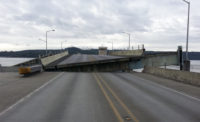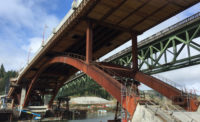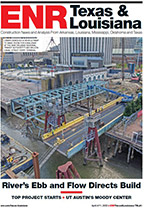Hood Canal Bridge Opens After Glitches Are Worked Out
The Washington State Dept. of Transportation escaped one last schedule hurdle in its planned opening of the new, $519.8-million state Route 120 Hood Canal Bridge, thanks in part to the ample time allotted for functional testing of the new west-half lift span.


The eastern half of the 1.5-mile crossing, which includes one of 11 permanent floating bridges in the world, opened last year after a 15-month delay due to the discovery of an ancient Native American village at the site of a planned graving dock. It connects the Olympic and Kitsap peninsulas, which are 60 miles north of Seattle.
One last hitch threatened to delay the project again. But what could have been a nightmare for the DOT and the general contractor, Omaha, Neb.-based Kiewit-General, was nothing more than an oil-flow issue. The new west-half lift-span hydraulic system, which retracts 300 ft of concrete floating bridge to allow vessel passage, performed poorly during final tests. About 300 ft of roadway slides underneath the lift span, which needed to lift 9 ft to provide ample clearance. Jeff Cook, WSDOT project manager, says the lift span has three equal sections and all must be level. But the rear hydraulic lifts of all three sections operated more slowly than the front lifts. “If it is not level, if there is binding and pushing—that is not what we want,” he says. “There is a measurable tolerance of 5 to 6 inches. They all had a front-to-back deflection of 16 inches.”
The issue came down to how oil flowed through piping and created pressure in the hydraulic components. “The flow rates weren’t even,” Cook explains. “The flows are now equivalent and we are good- to-go.” The deflection, after the oil-flow fix, is now less than 1 inch. The issue didn’t occur on the eastern portion, experts believe, because the west side was a retrofit, with some new and some old components trying to work together.
The delay hasn’t been very costly, Cook says, but it did push the finish of the project back three weeks and cost $20,000 in labor and engineering. The number of days with traffic delays for area residents was not affected. Cook says that WSDOT and Kiewit take equal responsibility for the issue. Kiewit declined to comment for the story.
“Functional testing caught this,” adds Cook. “We caught it before it became a long-term problem.” Functional testing resumed last week. Twenty consecutive proper span openings and closings will be performed before the project is considered a done deal, hopefully by the end of this month, Cook says.
The project’s overall goal is to prevent a repeat of the 1979 sinking of the western half, a result of 120-mph winds.





